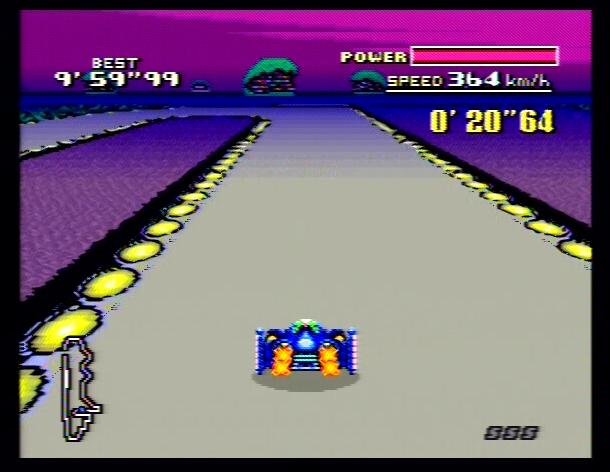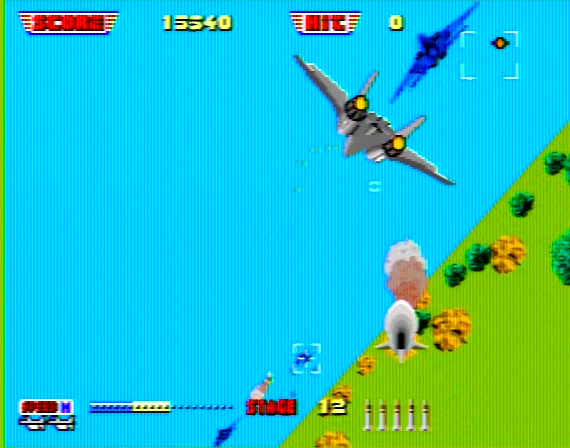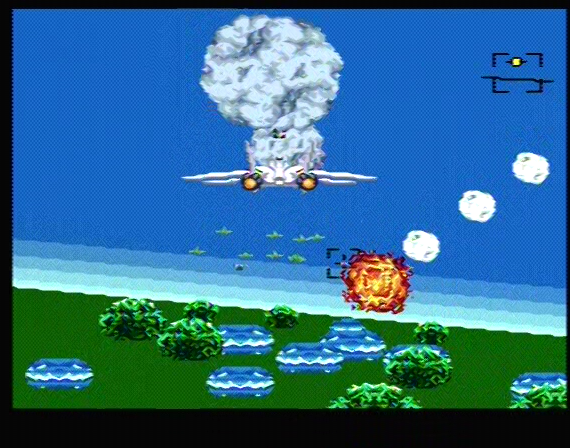1989-1990: Competing with Speculation
 Summer 1989, before NEC and Sega launched their 16-bit consoles, "Shooter" meant flying an advanced space craft against an evil armada and Nintendo, which owned ninety percent of the worldwide video game market, signified "video game."1 Before Fall, NEC focused its audience on the technical prowess of its newly dubbed TurboGrafx-16 and the merits of "16-bit gaming."2 NEC was not alone in advertising the generational leap, Sega also focused on a single characteristic turned marketing term for its new console, "16-bit."3 Undaunted, Nintendo Power, a magazine owned and operated by Nintendo, continued as it had for more than a year promoting Nintendo Entertainment System and then Gameboy portable games. Video game magazine start-ups Electronic Gaming Monthly (EGM) and Gamepro, however, mutually thrived on rumors and speculation about new hardware. In the same issues that extolled, for the first time, the soon-to-be released Genesis and TG16, both magazines devoted equal space to a "super" system from Nintendo.4 5 This represents an unprecedented public relations campaign for a game console that barely existed as a prototype.
Summer 1989, before NEC and Sega launched their 16-bit consoles, "Shooter" meant flying an advanced space craft against an evil armada and Nintendo, which owned ninety percent of the worldwide video game market, signified "video game."1 Before Fall, NEC focused its audience on the technical prowess of its newly dubbed TurboGrafx-16 and the merits of "16-bit gaming."2 NEC was not alone in advertising the generational leap, Sega also focused on a single characteristic turned marketing term for its new console, "16-bit."3 Undaunted, Nintendo Power, a magazine owned and operated by Nintendo, continued as it had for more than a year promoting Nintendo Entertainment System and then Gameboy portable games. Video game magazine start-ups Electronic Gaming Monthly (EGM) and Gamepro, however, mutually thrived on rumors and speculation about new hardware. In the same issues that extolled, for the first time, the soon-to-be released Genesis and TG16, both magazines devoted equal space to a "super" system from Nintendo.4 5 This represents an unprecedented public relations campaign for a game console that barely existed as a prototype.
 Marketing hype did not only affect video game related magazines. Journalist David Sheff, who authored Game Over in 1993, described most of the TurboGrafx game library as "not fun" or "unexceptional" to explain why the system's sales lagged behind competitors. Sheff also stated "the best entertainment-software companies were too busy making Nintendo games to bother making ones for TurboGrafx."6 Dismissing the early Genesis library as "sports games and arcade knockoffs," Sheff explained that Genesis developers created "great-looking games ... but not great-playing games."7 Sheff's analysis reflects the majoritarian view in the game industry from the late 1990s on, and is probably a result of his many developer and executive interviews rather than personal play time. Yet game reviews, and press coverage in general, were consistently more positive of the Genesis and TG16 than they were of Nintendo's NES from 1989 and 1990.
Marketing hype did not only affect video game related magazines. Journalist David Sheff, who authored Game Over in 1993, described most of the TurboGrafx game library as "not fun" or "unexceptional" to explain why the system's sales lagged behind competitors. Sheff also stated "the best entertainment-software companies were too busy making Nintendo games to bother making ones for TurboGrafx."6 Dismissing the early Genesis library as "sports games and arcade knockoffs," Sheff explained that Genesis developers created "great-looking games ... but not great-playing games."7 Sheff's analysis reflects the majoritarian view in the game industry from the late 1990s on, and is probably a result of his many developer and executive interviews rather than personal play time. Yet game reviews, and press coverage in general, were consistently more positive of the Genesis and TG16 than they were of Nintendo's NES from 1989 and 1990.
Emblazoned on the November 1989 cover of EGM was a close up screen image of Sega's award winning Ghouls n' Ghosts conversion for Genesis and a stamp reading "SEGA * SEGA: More Master System More Genesis." Steve Harris, Editor and Publisher of EGM, was pressured enough by readers to introduce his fourth issue excusing his magazine's tendency for Nintendo content.8 Harris also dedicated one fifth of his editorial to "owners of other machines" such as the TG16, and Atari systems. David White, an Associate Editor for EGM, maintained in the same issue that a "video game system is only as good as the games it plays" and asserted the TurboGrafx was the one system that stood above the crowd in this respect.9 In addition to reminding his audience of the ease of localizing successful PC-Engine titles to the TG16, White also began his Sega Genesis editorial with a full page about Sega Master System compatibility.10
Fall 1989 issues of Game Player's, a long running electronics magazine, dedicated dozens of pages to NES software and news, but had much to say about 16-bit consoles and their games. In a multi-page spread, Editor-In-Chief Tom Halfhill argued the merits of Sega's Altered Beast, which was a pack in game for the Genesis. Among his qualifications for "true arcade quality in your living room" Halfhill listed detailed and colorful screens that include multiple scroll layers, which he asserted "create an illusion of three dimensions." Smoothness and speed of character animation, "voice synthesis and stereo sound," and two player cooperative play were also listed as next-generation advantages due to "advanced computer chips inside the Genesis."11 Halfhill used similar terms when discussing the TurboGrafx CD-ROM add-on.12 Like EGM's David White though, Halfhill reasoned the merits of 16-bit gaming primarily in the context of game quality and reminded his audience that licensed games boosted console sales more than graphic and sound quality.13
Even in the new millennium, gameplay related comments on the Internet shine a dim light on at least three dozen worthwhile games released for the Genesis and nearly sixty for the TG16 by the end of their first full year.14 Among these games' developers were Data East, Hudson, Irem, Namco, NCS, and Victor for NEC's console and Asmik, Sunsoft, Electronic Arts, and Renovation for Genesis. Even without NEC and Sega's own offerings, these early third parties contributed greatly to the launch and first year libraries of both 16-bit consoles. Nintendo's NES had a monopoly on software developers and sales during these formative years, but exclusive and well received software was shared by all three of these game consoles.
 Gamepro accordingly progressed from its premier issue moniker "The Nintendo, Sega, and Atari Video Game Magazine," to include TurboGrafx, Genesis and Gameboy by the beginning of 1990. All game magazines were still subject to the dominant force in the industry. The majority of all game magazine advertisements in Gamepro and EGM during 1990 were for NES software, but majority rule affected EGM far more than Gamepro. EGM's Steve Harris contended, in summer of 1990, for his magazine's multi-platform objectivity even while he defended its position that the Genesis had proven itself "better" than the TurboGrafx-16.15 In the same issue that Harris argued EGM's judgments were exclusively about published games, EGM declared the still unnamed Super Nintendo "superior to anything that has every (sic) before been created." 16
Gamepro accordingly progressed from its premier issue moniker "The Nintendo, Sega, and Atari Video Game Magazine," to include TurboGrafx, Genesis and Gameboy by the beginning of 1990. All game magazines were still subject to the dominant force in the industry. The majority of all game magazine advertisements in Gamepro and EGM during 1990 were for NES software, but majority rule affected EGM far more than Gamepro. EGM's Steve Harris contended, in summer of 1990, for his magazine's multi-platform objectivity even while he defended its position that the Genesis had proven itself "better" than the TurboGrafx-16.15 In the same issue that Harris argued EGM's judgments were exclusively about published games, EGM declared the still unnamed Super Nintendo "superior to anything that has every (sic) before been created." 16
Nintendo's brand and largely incorrect hardware specifications was the only proof EGM needed of the SNES's preeminence. Harris' magazine listed the rarely used 512x448 interlaced resolution and 256 color modes for the SNES as though they would be used in the average game. A six page spread printed in EGM's December issue dubbed the Super Nintendo as "the ultimate in 16-Bit gaming" even before its Japanese launch.17 Gamepro, which had a special section every issue titled "The Cutting Edge," notably lacked any pre-launch editorials of the "ultimate" 16-bit console after its second issue back in 1989.
 Notable hardware, like NEC's portable TurboGrafx-16 the Turbo Express, were given full attention by Gamepro but suffered attached editorials about the Super Nintendo in EGM.18 19 As a result of these two magazines' competing views all three console manufacturers received much needed free publicity. EGM reasonably presumed that the next Nintendo console would take over when it was eventually released. Gamepro, which apparently was not sending representatives to Japan at the time, represented a more impartial exposition of new games and hardware. Only the next year could tell what the American public actually wanted, but it was evident by the end of 1990 that Nintendo was losing its hold on the US game console industry.
Notable hardware, like NEC's portable TurboGrafx-16 the Turbo Express, were given full attention by Gamepro but suffered attached editorials about the Super Nintendo in EGM.18 19 As a result of these two magazines' competing views all three console manufacturers received much needed free publicity. EGM reasonably presumed that the next Nintendo console would take over when it was eventually released. Gamepro, which apparently was not sending representatives to Japan at the time, represented a more impartial exposition of new games and hardware. Only the next year could tell what the American public actually wanted, but it was evident by the end of 1990 that Nintendo was losing its hold on the US game console industry.
- 1. David Sheff, Game Over: How Nintendo Zapped an American Industry, Captured Your Dollars, and Enslaved Your Children (New York: Random House, 1993), 349.
- 2. Sheff, Game Over, 351.
- 3. Steven L. Kent, The Ultimate History of Video Games (New York: Three Rivers Press, 2001), 401.
- 4. Steve Harris, "The Amazing Super Nintendo," Electronic Gaming Monthly, August 1989, 39.
- 5. Steve Massey, "The Cutting Edge: Super Famicom. The Next Generation from Nintendo," Gamepro, July 1989, 13.
- 6. Sheff, Game Over, 351-52
- 7. Sheff, Game Over, 355
- 8. Steve Harris, "insert coin: You Asked For It, You Got It... More Sega!!!," Electronic Gaming Monthly, November 1989, 6.
- 9. David White, "Turbo Champ: TurboGrafx Explodes With Games!," Electronic Gaming Monthly, November 1989, 64.
- 10. David White, "Outpost: Genesis, The Master System Lives On!," Electronic Gaming Monthly, November 1989, 70.
- 11. Tom R. Halfhill, "Altered Beast: Arcade Action On The Genesis," Game Player's, October 1989, 42-44.
- 12. Halfhill, "NEC's TurboGrafx-16 CD: Plenty Of Potential," Game Player's, October 1989, 18-22.
- 13. Halfhill, "The EDITORS VIEW," Game Player's, November 1989, 4.
- 14. Notable Games: 1989-1990, http://www.gamepilgrimage.com.
- 15. Steve Harris, "The Genesis/Turbo Debate Concludes...," Electronic Gaming Monthly, July 1990, 6.
- 16. "Super Famicom Update ... 16-Bit Nintendo Close To Production!!," Electronic Gaming Monthly, July 1990, 29.
- 17. "Super Famicom Special," Electronic Gaming Monthly Presents the 1991 Video Game Buyer's Guide, December 1990, 28.
- 18. "The Whizz," "The Cutting Edge: The TurboExpress Handleld System," Gamepro, August 1990, 18.
- 19. NEC To Show Turbo Express at CES...First On-Hands Tests Reveal Superiority," Electronic Gaming Monthly, July 1990, 30.
- Printer-friendly version
- 14983 reads